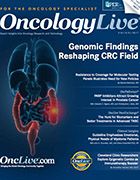Leukemia Researcher Sees Exciting Prospects for New Targeted Agents
Jeff Sharman, MD, discusses the prospects for progress in targeting elements of the BCR pathway.
Jeff Sharman, MD

Jeff Sharman, MD
As a researcher specializing in chronic lymphocytic leukemia (CLL), Jeff Sharman, MD, has been involved in the clinical development of several groundbreaking new drugs, including agents that target the B-cell receptor (BCR) pathway. Sharman is director of research at the Willamette Valley Cancer Institute in Springfield, Oregon, and the medical director of hematology research for the US Oncology Network.
How is the BCR pathway being targeted for anticancer therapy?
He discussed the prospects for progress in targeting elements of the BCR pathway in an interview with OncologyLive®.The BCR pathway has been identified as a useful target for therapeutic intervention in many B-cell malignancies. This pathway involves a variety of targets, including the proximal molecules BTK and PI3K, which are targeted by the approved medications ibrutinib and idelalisib, respectively. Many second-generation molecules targeting the same proteins are likely to be approved in the coming years. Additionally, distal molecules in the pathway such as BCL-2 can be inhibited by small-molecule inhibitors such as venetoclax, which has gained its first regulatory approval, with more likely to follow.
In your opinion, what are the most promising drugs in development?
How are these drugs being incorporated into treatment approaches?
How is the issue of resistance to these drugs being addressed?
Beyond these targets, others are being investigated, such as SYK tyrosine kinase and phospholipase C-gamma. BCR inhibitors have been approved in CLL, small lymphocytic lymphoma, mantle cell lymphoma, marginal zone lymphoma, follicular lymphoma, and Waldenström macroglobulinemia. In many cases, these medications combine levels of activity not previously seen with immunochemotherapy and are associated with side effect profiles that are considerably improved.Ibrutinib, idelalisib, and venetoclax have all been FDA approved. In addition, multiple second-generation inhibitors targeting the same molecules are in clinical development. Acalabrutinib (ACP-196), targeting BTK, and TGR—1202, targeting PI3-kinase, are in phase III development. It is possible that these could be approved in the next 1 to 3 years.Ibrutinib has gained the most widespread incorporation in B-cell malignancies. In most cases, it is being used as a single agent although current trials are determining whether the addition of anti-CD20 antibodies enhances the activity of ibrutinib. Idelalisib currently has somewhat more limited use in the salvage setting for CLL, small lymphocytic lymphoma, and follicular lymphoma. Venetoclax is currently approved as a single agent in relapsed CLL with deletion of chromosome 17p; however, the labeled indications are likely to expand as additional studies read out. This medication will likely soon be available in both the general relapsed/ refractory setting as well as a possible frontline setting in combination with obinutuzumab.The observation that CLL resistant to ibrutinib typically has mutations in BTK or PLC-gamma has highlighted the central role of BCR signal inhibition for these medications. It appears that these mutations may develop many months before clinical progression occurs. Currently, testing for these mutations is not broadly available, but could be considered for patients on therapy.
What are the most significant unanswered questions or challenges?
The mechanisms of resistance for idelalisib and venetoclax have not yet been identified. Patient adherence to ibrutinib is equally important to clinical resistance. Unfortunately, this medication is associated with some mild side effects that in the chronic setting, have led to suboptimal treatment adherence. Patients need to be counseled about optimal drug adherence in order to gain the maximum efficacy from the medication.We are really just at the forefront of this new and exciting eld. We have gotten several drugs approved as single agents or in combination with CD20 antibodies; however, the next generation of clinical trials will greatly enhance our knowledge of how to combine these drugs with existing therapies. Venetoclax may benefit from a debulking strategy in order to minimize the risk of tumor lysis. BTK and PI3-kinase inhibition may be enhanced with second-generation drugs. Combinations of each of these medications could also lead to enhanced activity.




